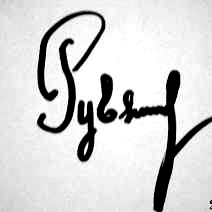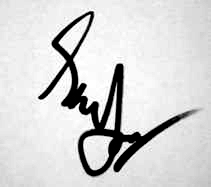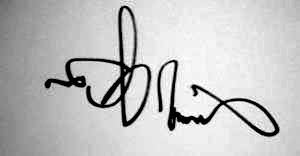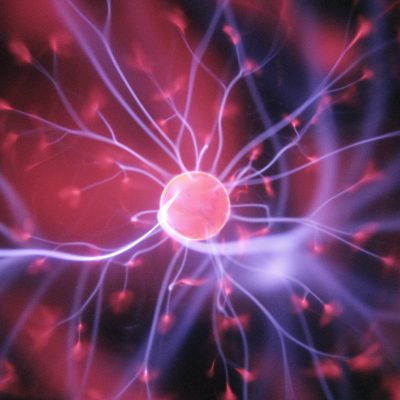1. Question:
Hello!
The signature of my friend who is an excellent student is as follows (Fig. 1). He is a smart person, but he is not good at anything. What does his signature say?

Psychologist’s Answer:
Hello!
Thank you for your question. His signature does speak of consistent and logical thought, diligence and correctness, tendency to economic miscalculations, analysis.
Analyzing the signature is a voluminous work, but in key features this signature suggests that he unfolds his idea, a task, a new project in the first couple of years, devoting great importance to it. The work encounters difficulties and ends miserably (the end of the signature points downward). Then the condition stabilizes and he regenerates a new idea.
This applies to this person’s life strategy as well; he acts this way in many ways.
Try to help your friend change his attitude toward projects and new ideas. After all, with changes in a person – his handwriting changes.
People with this signature – can make enough money with their minds. But by nature they are cautious.
2. Question:
Hello!
What does this signature say?

Psychologist’s Answer:
The signature (Fig.2) looks like the signature of a doctor or a person who puts it very often. It is done hastily. This person may have 2 or 3 signatures.
The person is interesting and has deep knowledge in one direction.
Shows interest in things that are not related to his professional activity.
Often tired at work, in the house – sees a “fortress”, but often does not value relationships. Self-assertion – is not important to him so much that he “beat his head against the wall”. Equilibrium is achieved in everything new.
3. Question:
Hello!
My acquaintance has a strange signature (Fig.3). It resembles foreign letters, but she is Russian and has never been abroad, not into tourism. Her signature made me suspicious, but I don’t know why. What can be said about it?

Psychologist’s Answer:
Hello!
In general, signature analysis includes a large number of parameters, which add up to one picture and form a graphological portrait.
Having analyzed the given signature on the basic criteria, it is possible to tell the following: the person specifically thinks, more often in detriment to itself (probably symptomatology of paranoia, phobias, psychotraumas) it is necessary to find out.
Tendency to fascination with abnormal forces, beliefs, omens. Tries to live by special rules, to attract only the right people. Tries to conclude questions logically and is always afraid to tear up relationships.
Feels attachment and dependence in normal communication. Something has affected the person mentally and put the destructive beginning forward. Suffers from depression and loneliness, even with noisy surroundings.
Strives for independence and strength.
4. Question:
Hello!
I subscribe in this way (fig.4). What can you say about me?

Psychologist’s Answer:
Besides the fact that you are left-handed (by the way, it should be specified when ordering a graphological portrait, it is very important) and creative, there are many interesting things. For example, you are inclined to art, music, you like design.
You are an optimist. You are cheerful most of the time and are on the lookout for things.
You have values that you protect and value very much. You are not greedy or stingy, but you are an over-enthusiastic person.
In addition, you are suspicious and jealous.
5. Question:
Hello! My name is Lera. How can you characterize me as a person by my signature (Fig.5)?

Psychologist’s Answer:
You are artistic and very flirty. I think you would be happy to sign autographs (or do so).
You have a sense of taste and restraint, you are logical but eccentric. Selfish, demonstrative person (which is not bad in your case), but stubborn.
Can draw or create some creative masterpieces.
Fall for money and capricious.
Love excitement and success. Agree to a double, but interesting life. Not a homebody.
It is possible that you have more than one signature, or that your signature may be different.
6. Question:
Hello! My uncle has this signature (Fig. 6). What kind of person is he?

Psychologist’s Answer:
Weak faith, prone to cardiovascular, nervous system diseases, a little insecure, although he tries not to show it.
Your uncle is more tactician than strategist.
Tends to double-check a lot of things in his life, looking for mistakes and errors. Hard to let go of the past.
Experience is very valuable and uses.
Offensive, listens to the opinion of others.
7. Question:
Hello! What does the end of this caption (fig.7) mean? The beginning – as told by the author – means “arrow up”.

Psychologist’s Answer:
The second part of the signature indicates that the person likes to tell about the results of his cases. Not always satisfied with the outcome of work, makes claims and dissatisfaction.
In general, thinks systematically and finds effective solutions.
Likes to do work that consists of small stages and gives a quick result.
Interesting interlocutor, although the topics he chooses are complex and very multifaceted.
This person would make an excellent lawyer – consultant, design engineer.
8. Question:
Hi. Why are there so many vertical bars in my acquaintance’s signature (Fig.8)?

Psychologist’s Answer:
Probably because he is a sharp person, although at the beginning of any communication he feels curiosity and some kind of interest. A lot of barriers, obstacles, even complexes. Further relations are more difficult for him, the prospects there are washed out and unclear. Often they are stopped by him.
He is not a strategist and does not always go to contact.
Cautious, stubborn, arrogant. Self-confident in appearance, often doubts his actions. Categorical and imaginative.
In certain situations, is able to become cruel, cold and sarcastic.
Demanding. Busy and picky.
Malignant. Does not forgive mistakes.
Such people can be/become members of a cult or group. Able to work in a team and lead people as professionals, without special training.
9. Question:
Hello! My boss has this signature (Fig.9). Why so many circles?

Psychologist’s Answer:
Probably because a person is frugal, prudent, organized, miscalculation is his element.
Such a person analyzes and considers everything, does not overlook anything. Spins around a lot of issues at the same time.
In general cheerful and kind.
Does not trust anyone, but if you rub in his trust – all will be well.
Values performance, respect and courtesy.
Such people have a good memory.
Good specialists in their field.
10. Question:
Hello!
I am sending the signature of my new acquaintance (fig.10). He is strange and so is the signature. Why?

Psychologist’s Answer:
This signature is abnormal.
Most likely, the person has a mental deviation. The signature is unnecessarily complicated and overloaded with information.
Repeating the signature seems laborious.
This person has problems both in communication and in perception of the surrounding world in general.
The presence of a pathological deviation.
11. Question:
Hello!
The head of my department signs documents with a small-sized signature (Fig.11).
It is half the size of a regular signature.
What does this mean?

Psychologist’s Answer:
This person, judging from the signature, is characterized by reticence, shrewdness, curiosity, sarcasm, judgmentalness, suspiciousness.
A good performer.
Demanding.
Control is his favorite pastime.
Committed, but often forgetful.
Appreciates respect for his person and kindness.
Meticulous, boring.
Hard-working, present apprehension. Cowardly and dependent on leadership.
Very eager to get rid of responsibility (it “overloads” his head).
As for the size of his signature – it speaks of his low self-esteem, painful caution and psychological trauma of childhood (violent actions against this person).
12. Question:
Hello!
My fiancé sent me flowers (wishing me a speedy recovery from the flu) with this signature (fig.12).
I see his signature for the first time, how can I characterize it?
And the second question: what guarantees does graphological study give?

Psychologist’s Answer:
People who sign in this way, big dreamers and inventors – in terms of pluses, as well as demonstrative and resentful. Most often their height is below average.
Their activities begin boisterously preparing, do not always tune in to a normal dialog. Express claims and dissatisfaction, like to tease.
The dot at the end of the signature – here speaks about the finality of thoughts, accurate conclusions about almost every issue and certainty, as well as their own position, escape from pressure and imposition.
However, he likes to complicate things, gets upset about little things and looks for faults. He should calm his nervous system a bit.
In answer to your second question, I will say that graphological portrait has in potential a scheme and features that determine a number of key features of a person’s handwriting and signature. People don’t realize many of the things they do. A detailed analysis of this kind of thing can explain what may later develop into a conflict or problem.
If we talk about guarantees, the main task of graphological study is to determine what is important in a person. Whether it is positive or negative for you directly is for you to decide. And whether the knowledge that you can use in such a way as to understand the clue is a guarantee for you – again it is up to you, because it depends on each individual person.
13. Question:
Hello! Does it matter if a person is a foreigner or not? For example, this signature (Fig.13).

Psychologist’s Answer:
Yes, it matters a lot.
It also matters where the person was born and what languages he or she speaks. For more information, you can refer to our website, there are all the requirements for writing a graphological portrait.
For example, let’s take this signature.
If a person is not a foreigner, for example Russian, this person is interesting and multifaceted. Likes to read and analyze. Good business acumen. The person’s signature indicates a miscalculation based on facts, cooperation and partnership. He tends to use his past experiences for control purposes.
If it is the signature of a foreigner, the meaning is different as the person himself thinks differently.
This person is tough and demanding, self-confident and not poorly provided for. Strict to others, does not like to communicate with strangers. Values friendship, but friends have very few. Skeptic, a little nerdy.
A little different people turn out. The whole point is that the thinking of a person of the same country, faith, mentality is significantly different from others, because of the different environment, culture, history. Everything in graphological analysis is taken into account, because this work is built on details.
14. Question:
Hello!
I am 30 years old. My problem is my handwriting remains childish. I am a normal healthy, from the point of view of psychiatry, person! And here it is! When I write a note to my child at school, the teacher thinks it’s a forgery and calls me to the school about the child cheating. Why would that happen?
Psychologist’s Answer:
Interesting question, thank you. I’m sorry you didn’t send an example of your handwriting. It would be possible to study it more closely.
As for child handwriting in an adult, there could be several reasons. And one may be so different from the other that it needs to be analyzed separately.
I still think that in your case – psychologically you are a defenseless child, it is fixed in your handwriting and signature. Thus, your Subconsciousness lets you know about it. And if you have a need to change – you should think about it. And I think there is a need only for the reason that you care about it.
How exactly to change – start by working on yourself in the area of self-development and parallel relaxation. For example – sign up for self-confidence training. It seems to me that you will learn more about yourself and this will set you on the right path of improvement.
15. Question:
Hello!
Are there strange signatures from the point of view of graphology? For example, this one (Fig.14)
And another question. Tell me, what if a person has got an injury of the hand he writes with, how then?

Psychologist’s Answer:
About the weird signatures, the answer is both yes and no. The fact is that all signatures are individual. How can they be weird? They’re just different. But on the other hand – people suffering from mental disorders do sign abnormally, for example, loading the signature or painting it in all sorts of ways.
The signature you presented is interesting. It is the signature of a person who is introverted, well versed and practiced in one, probably more technical, field.
Literate, but greedy. He is reluctant to take on new endeavors because he is afraid of deception, excessive risk and unnecessary hassle. He needs normal working conditions – and everything will be fine. However, he is a little bored in life, because he loves new impressions.
To answer your question about the injury, we can say the following. Until the hand develops, it will be difficult to sign again. After recovery, there are cases when the signature does not change – this happens if the person himself does not change in any direction. And it changes – accordingly, when the person changes.
The hand, as they call it, remembers the signature and handwriting (if the injury is not cardinal). It remains to wait and check whether there are changes in the person himself.
16. Question:
Hello!
That even by this kind of signature you can say something (Fig.15)? Victor

Psychologist’s Answer:
Hello, Victor!
You can learn a lot of interesting things from such a signature. It’s a foreign citizen, self-confident. Prone to financial business, more precisely to lending. Please indicate if the person is left-handed! It’s very important.
A person who signs this way is logical, consistent and likes specifics. Initially, questions everything about financial contributions. Interested in new perspectives.
Feels comfortable working in a team of professionals.
Analytical in mind.
17. Question:
Hello!
Does it matter if the signer is a woman or a man?
Psychologist’s Answer:
Yes, everything matters.
For a more professional study, it is desirable to specify age (date of birth, month, year) and gender. In this way, the analysis will be more complete and in-depth.
Women – put one informative value, men – another.
If gender is not specified – the analysis is carried out according to the criteria of the person’s qualities, covering all spheres of his life.
18. Question:
Hello!
If I send an example of handwriting of a child, aged 8 years, can I make a graphological portrait?
Psychologist’s Answer:
Of course. At this age, children write well, their handwriting is formed. All inclinations and orientations are visible. Of course, a graphological portrait can be made.
In addition, you can ask the child to sign. If he has already thought up a signature, it is good. If he will come up with it in front of you (but without your help) – it is also good. Such creative work will reveal his/her individuality, prompt you to those directions, on which it may be necessary to emphasize.
19. Question:
Hello!
Please tell me, I know a person. He used to sign his name like this (Fig.16) and now like this (Fig.17). Something has changed in him. The gap between these signatures is 1 year. The man is now 28 years old. Why did this happen? Anton.

Fig. 16

Fig. 17
Psychologist’s Answer:
Hello!
Anton, thank you for the accurate data!
The change is obvious. The influencing factors may be different – from unrequited love to age crisis. However, the person has changed, and therefore his signature.
In order to establish the possible causes of change, you need to study the person by the method of psychological portrait, focusing on this feature.
As for the graphological part – let’s find out.
The initial signature is that of an uncertain person. There is a certain impression that the hand was cowardly. There is a clearness of signs (these are letters), sequence – without unnecessary deviations to the sides. This is how people who are thorough, sincere and nervous at the same time sign. Such a signature is executed slowly, without fuss, with attention. The first letters – are separate – which indicates a correct and conscious position.
The second signature – already a confident person who adheres to his position. The first letters – a single sign – all simplified and entered into its own system, which now leads a person through life. Notice that a sign before the signature (a certain zigzag) has been added. And it, this sign – completes the first stage of the signature, not starts it!
A certain disregard for the past indicates that a person, having realized or passed something, has changed much faster than it is typical for him. For example, having money changes a person in this way.
The new signs that have been added to the signature say that man is no longer as simple as he seems. He has his own secrets, his own projections.
This man, from now on, has revealed himself in such a way – he has become demonstrative, more free, strong, firm, judicious. A kind of – he has “let himself go” from busyness and illness.
The signature in both cases consists of 2 separate parts. In the first – it speaks of a kind of conservatism, stiffness. In the second case, it indicates creative thinking, division of many issues into parts, levels, stages, incoherent (rushing from side to side) thinking.













